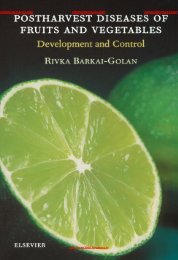M A N G O
Mangoes - Guyana Marketing Corporation
Mangoes - Guyana Marketing Corporation
- No tags were found...
You also want an ePaper? Increase the reach of your titles
YUMPU automatically turns print PDFs into web optimized ePapers that Google loves.
Mature fruit may also exhibit tear stains, in which the anthracnose spores wash along in spore-laden<br />
water droplets falling from infected twigs and panicles above the fruit. This results in a vertical spotting<br />
pattern (Figure 5).<br />
M<br />
A<br />
N<br />
G<br />
O<br />
Fig 5. Tear staining symptoms of anthracnose infected<br />
mango fruits.<br />
Ripe yellow colored fruits are much more susceptible to anthracnose than mature green fruits. However,<br />
the infection process generally begins on the tree when the fruits are green. The fungal spores often<br />
remain dormant on the surface of the mature green stage fruit, but rapidly develop and penetrate the<br />
surface of the weaker and softer yellow skin as the fruit ripens. Anthracnose is always more severe<br />
during the rainy season. Buxton Spice fruit is highly susceptible to anthracnose. Long fruits are also<br />
susceptible, but are generally less severely affected because of their tougher skin.<br />
Management and control of anthracnose decay begins in the field. Proper cultural practices are necessary<br />
to avoid the build-up of high levels of inoculum responsible for postharvest decay. These practices<br />
include proper tree spacing to avoid crowding, periodic pruning to allow more air movement through<br />
the canopy, monthly foliar fungicide applications (i.e. mancozeb, benomyl, iprodione, propiconazole,<br />
and/or copper fungicides), and removal of fallen leaves under the tree. Manipulation of the time of<br />
flowering (i.e. using KNO3 foliar sprays) so the fruit ripens during the drier months is another way to<br />
reduce anthracnose decay.<br />
Several postharvest decay control methods are useful in reducing the severity of anthracnose fruit rot.<br />
They are effective in eradicating quiescent infections of the fungi that have become established on and<br />
beneath the cuticle and within the pedicel. Treatment effectiveness varies with infection level and storage<br />
temperature. The first decay control method involves submerging the fruit for 2 to 5 minutes in 50°C to<br />
55°C (122° F to132° F) water or 5 minutes at 48° C to50°C (118° F to122° F) water. Control of the<br />
water temperature and the length of submergence are critical for effective anthracnose control. If either<br />
the temperature or duration of submergence is exceeded, fruit injury will result. On the other hand, if the<br />
temperature is too low and/or the duration of submergence inadequate, the treatment will be ineffective.<br />
The second method<br />
169 169





